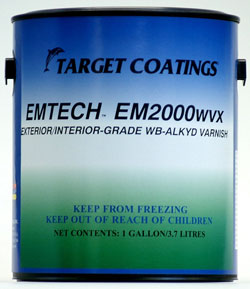Thanks for another insightful article Brent. Readers may want to explore our evaluations of wood finishes in Pharos, too. We have evaluated, so far, natural oil-based and waterborne (mainly urethane-based) finishes.
Blog Post
Minimizing Exposure to Chemicals in Clear Wood Finishes
High-VOC content is still the norm in clear wood finishes, but depending on the application you can minimize exposure and maximize durability.

Clear finishes can help protect woodwork against aging, scratches, moisture, and the chemicals found in common cleaners. There are natural, low-toxicity options for residential furniture, and factory-applied chemical finishes for commercial architectural woodwork, but there is no environmentally perfect finish.
Here at GreenSpec, when considering which coatings to list, we look for finishes that are low-VOC; contain no heavy metals, phthalates, or aromatic solvents; and/or are natural products with less environmental burden. Durability and ease of maintenance are important, too, so select the least toxic alternative with the greatest durability for the end use.
High VOCs are more the norm than exception
Clear finishes contain more solvent and fewer solids than paints, making high VOC content the norm. The current South Coast Air Quality Management District (SCAQMD) limit for VOC emissions from clear finishes is 275 grams per liter (g/l), 250 g/l for stains, and 730 g/l for shellac--all relatively high levels when you consider that zero-VOC paints are now common.
Not all VOCs are equal, however. Emissions from shellac, for instance, come from relatively benign ethanol (alcohol), whereas some lacquers emit toxic toluene and xylene. Waterborne polyurethanes use glycol ethers that are reproductive toxins. There are also exempt solvents--chemicals that scientifically are VOCs but are not regulated as much--such as acetone being used in place of more toxic alternatives.
Where a finish is applied is also relevant. Factory-applied finishes often have higher initial VOC levels but are allowed to fully cure before installation and so may pose less of an indoor air quality concern.
Natural oils sometimes aren't so natural
Natural oils, such as linseed and tung, have been used as wood finishes for centuries. Sometimes called drying oils, they are applied as a liquid and penetrate wood pores. When exposed to air, they oxidize to form a protective finish. These oils bring out the wood grain, but because they scratch easily they are not ideal for heavy use areas.
SUPPORT INDEPENDENT SUSTAINABILITY REPORTING
BuildingGreen relies on our premium members, not on advertisers. Help make our work possible.
See membership options »Linseed oil, pressed from flax seed, is easy to apply. You simply rub it on and wipe it off after it soaks in--but it takes weeks to "cure," looks perpetually wet, and can support mildew growth, so it is impractical for most woodworking outside of some residential or specialty applications. Polymerized linseed oil is heated during production and dries faster, but this should not be confused with "boiled" linseed oil (BLO), which can contain heavy metal drying agents. Many companies have moved away from cadmium and lead agents and are using less-toxic cobalt, but that is still an aquatic toxin and not recommended.
Tung oil, from the seeds of the tung tree, forms a much harder (though still relatively soft) surface than linseed oil, resisting water and even some solvents. It also dries much faster and doesn't need drying agents, but it doesn't cure overnight, and you need to use many coats. It takes time, skill, and patience to apply a tung oil finish, making it impractical for large surface areas or most commercial applications. Tung oil also has an odor some people find unpleasant and can even trigger nut allergies in some people.
If you are looking to use natural oils, especially on a food-contact surface, check the ingredients on the label or MSDS;. Many products advertised as tung or linseed oil can contain petroleum-based, high-VOC thinners, oil substitutes, or heavy-metal drying agents, and they might not contain any tung or linseed oil at all.
Wood finishes from beetle secretions
Shellac also traces its roots back to antiquity. Made from resins secreted by the lac beetle of Thailand and India, shellac is sold in flake form and/or dissolved in alcohol.
Shellac finishes do not penetrate the wood and are easily scratched or damaged by water and alcohol, so they are not used in most commercial applications, but the damage is also relatively easy to repair, so it can be a good choice in lower-traffic areas. Shellac is used primarily as a wood sealant under more durable finishes, though the wax in shellac makes it incompatible with some polyurethane products.

"Varnishes" and other coatings
Once you move past these natural products, you trade in lower toxicity, gaining better durability and application speed.
"Varnish" is a catchall term for drying oils combined with acrylic and or polyurethane resins. The acrylics and polyurethanes are used for strength, and the oils aid in curing. These products form durable coatings but usually contain flammable, toxic solvents and are slowly being replaced by waterborne formulations.
Waterborne polyurethanes and acrylics can provide a similar durable, low-VOC finish. Not as safe as natural oils but far less toxic than those that contain aromatic solvents, waterborne acrylics and polyurethanes (they are often blended) contain glycol ethers as solvents, which are reproductive toxicants. If not properly applied, waterborne products can raise the wood grain and makes the wood look like it's coated in plastic. Repairing a damaged varnish finish (waterborne or solvent) is difficult.
Professional finishes
For commercial and residential architectural millwork, nitrocellulose lacquers that contain solvents are still common because they spray on and dry quickly so they can be sanded between coats. Less durable than varnish and waterborne polyurethanes/acrylics, these lacquers have very high VOC levels and use some of the most toxic solvents out there. Concerned about worker and occupant health, and motivated by customer requests, companies have now formulated waterborne "lacquers" that can be sprayed like lacquer but don't contain nitrocellulose.
All of these site-applied products have their positive performance attributes, but some pose significant health and environmental risks.
If possible, spray it at the factory
When possible, have woodwork sprayed at a factory and allow products to cure fully there. This also allows the emissions to be captured before entering the environment--or your building. There are quite a few Greenguard-certified products available that are factory-applied, but they are largely production-line products and require specific cure times (usually between 3 and 14 days) before the woodwork can be installed.
People with chemical sensitivities may find some wood finishes problematic, but allowing these finishes to fully cure should minimize indoor air quality concerns. GreenSpec lists a variety of wood finishes , and have added some new commercial finishes, so there are products to meet most any application.
Published April 18, 2012 Permalink Citation
(2012, April 18). Minimizing Exposure to Chemicals in Clear Wood Finishes. Retrieved from https://www.buildinggreen.com/blog/minimizing-exposure-chemicals-clear-wood-finishes
Comments
But keep in mind that most cl
But keep in mind that most clear finishes (with the possible exception of those with nano-particles of pigment) will not offer the UV protection of even moderately pigmented finishes. Wood reacts to UV (photochemical degradation) in much the same way that our skin does. Exterior wood is particularly vulnerable to the combination of UV breakdown of lignin, water absorption, mold and freeze-thaw damage.
Zinc oxide offers far more protection than sunblocks on our skin and doesn't need to be re-applied as often, and the melanin (pigment) content of skin is the primary determinant of natural UV resistance. For the same reason, pigmented finishes offer more UV protection and require less regular re-coating.



Add new comment
To post a comment, you need to register for a BuildingGreen Basic membership (free) or login to your existing profile.